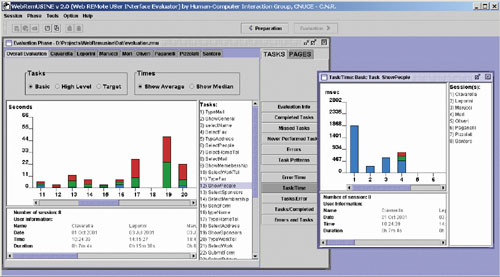 This issue in pdf Archive: |
|
|||
WebRemUSINE: A Tool for Usability Evaluation of Web Applicationsby Laila Paganelli and Fabio Paternò Creating a Web site allows millions of potential users with various goals and knowledge levels to access the information that it contains. For this reason, interest in usability evaluation of Web sites is rapidly increasing. We have developed a method and an associated tool to detect usability problems in Web interfaces through a remote evaluation where users and evaluators can be separated in time and space. Our approach combines two techniques that are usually applied separately: empirical testing and model-based evaluation. The reason for this integration is that models can be useful to detect usability problems but their use can be much more effective if they can be related to the actual use of a system. Our tool is able to analyse the possible inconsistency between the actual user interactions and the task model of the Web site that describes how its concrete design assumes that activities should be performed. To support remote evaluation, we have developed a technique that makes it possible to record user actions during a site visit. The analysis of the log data is based on a comparison of the traces of actions performed with the structure of the task model. This analysis provides evaluators with a number of results that are related to the tasks that users intend to perform and the Web pages and their mutual relationships. In our case we follow a hybrid approach because our environment is able to analyse data relative to user interactions and then compare them to the task model corresponding to the design of the Web site. The solution that we have adopted in WebRemUSINE to identify user intentions is to display the high-level tasks that are supported by the Web site asking the user to indicate explicitly what task they want to perform. WebRemUSINE compares the logs with the task model and provides results regarding both the tasks and the Web pages supporting an analysis from both viewpoints.
The method is composed of three phases: preparation, which consists of creating the task model of the Web site, collecting the logged data and defining the association between logged actions and basic tasks; automatic analysis, where WebRemUSINE examines the logged data with the support of the task model and provides a number of results concerning the performed tasks, errors, loading time; and evaluation, the information generated is analysed by the evaluators to identify usability problems and possible improvements in the interface design. The environment is mainly composed of three modules: the ConcurTaskTrees editor CTTE) (publicly available at http://giove.cnuce.cnr.it/ctte.html); the logging tool that has been implemented by a combination of Javascript and Java applet to record user interactions; and WebRemUSINE, a Java tool able to perform an analysis of the files generated by the logging tool using the task model created with CTTE. Link: Please contact: |
|||


